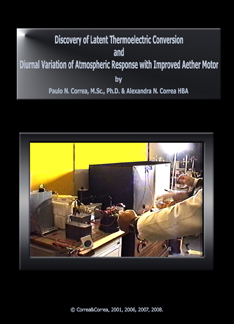![Akronos logo]](/images/akronos_wheel.jpg)
|
Akronos Publishing Concord, ON, Canada www.aetherometry.com |
![Akronos logo]](/images/akronos_wheel.jpg)
|
Akronos Publishing Concord, ON, Canada www.aetherometry.com |

The rediscovery of the ORgone motor:
(4) Discovery of latent thermoelectric conversion and
(5) Diurnal variation of atmospheric response with an improved Aether Motor
by Correa, Paulo N. & Correa, Alexandra N.
Published in July 2006. 70 pages.
Experimental Aetherometry, Vol. 3
Monograph AS2-20
Price: US $35
Chapter 3 of the book The (Re-)Discovery of the Orgone Motor
|
ABSTRACT
In this communication the Correas present two lines of evidence: one line, rather unexpected, indicates that in the T/R gap of their TC-sourced, doped semi-conductor Y-fed, PAGD split-phase motor drive, there is an anomalous injection of 'latent thermal energy', and that this energy injection can be promoted by increased evacuation of the T/R gap region. The second line demonstrates that a parallel energy injection, of sensible heat, and likely also of latent heat, occurs inside Orgone Accumulators (ORACs), and that this is a phenomenon which is detectable, and can be directly exploited, when ORACs are coupled to the Correas' improved Tesla power transmission system and Aether/PAGD Motor drive. A study of the variation of the motor response in the improved overall system employing a specially designed outdoors ORAC (that couples the T/R cavity with an ORAC chamber) confirms that the response varies diurnally with the earth's rotation, and that this pattern is interfered with by cloud-systems associated with Low-Pressure (LP) cells. The authors also study how the improved Aether/PAGD split-phase motor drive responds to the superimposition of diverse unipolar sources of energy, confirming that it shares the fundamental properties which Reich associated with the functioning of his 2-phase Orgone Motor circuit(s). This means, in summary, that Aether Motors can be directly driven (1) from any ambipolar transmitters (solar radiation, Tesla coils, living systems), and (2) from the superimposition of two or more receivers, which can variously be special radiation cavities, ORACs, the earth ground, Tesla antennas, etc. All these are coupled via Function Y circuitry. The Correas further identify the operation of Function Y or wave-divider circuits as involving the superimposition of two distinct massfree energy signals, at the Y and X junctions of the Y circuitry. |